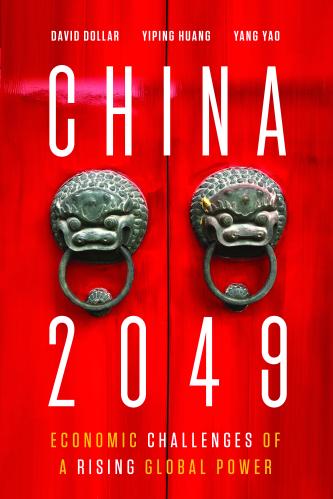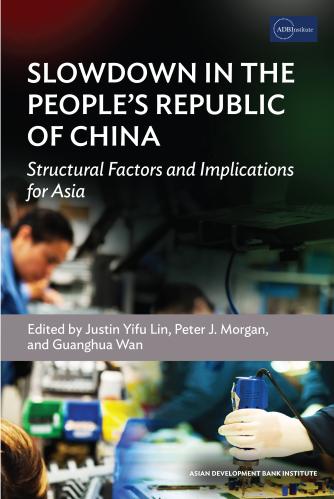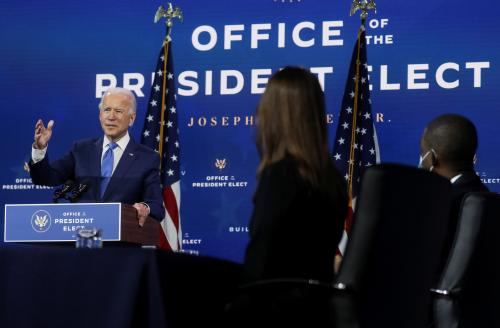In this piece, which originally appeared in the East Asia Forum, David Dollar analyzes China’s domestic and international challenges for economic growth over the next several decades, and reviews potential policy avenues that Beijing may take to address them.
China’s well-known story of spectacular growth, at around 10% annually for 40 years, is coming to an end because of both domestic and global factors. In analyzing China’s prospects for the next several decades, three particular challenges are striking: the shift from a labor-surplus to a labor-scarce society; the shift from investment to innovation as the primary source of growth; and the shift in China’s global position from a rising power to an established power.
Rapid aging is probably China’s biggest domestic challenge. The population over 65 will increase from 200 million today to 400 million by 2049, while the overall population will decline slightly. Within this group, the most rapid rise will be in the population 85 and older: from fewer than 50 million today to over 150 million in 2049. The challenge of taking care of the elderly is compounded by China’s rural-urban divides.
Most of the elderly live in the countryside, though often their working-age children have moved to cities as migrant workers. Since rural health systems are weaker than urban ones, taking care of the elderly will require more permanent migration to cities plus strengthened rural service delivery. China needs to scrap the hukou household registration system that limits permanent migration and to unify rural and urban pensions, health insurance, and educational systems. This will be good both for social objectives and the efficient use of labor.
Dealing with aging is first and foremost a quality-of-life issue, but it also has economic implications. China’s labor force will shrink, but by how much and with what impact remains to be seen. As China’s workforce shrinks, the 55-64 year-old cohort will increase dramatically. Keeping this group and the “young olds” (65-85) healthy and active is China’s best hope for staving off a dramatic labor force decline. Improving rural education is also critical because about half the workers of the future are attending school in the countryside. Deficiencies in their education will affect China’s growth for years to come.
China is counting on robots and automation to fill the gaps in the labor force, but it is impossible to make the pace of automation match declines in particular types of jobs. The social safety net and retraining programs will be increasingly important to help people shift as the job picture shifts.
A second domestic weakness that China needs to address is its overreliance on investment and underperformance on innovation. The financial system adequately channeled resources to investment during China’s rapid growth phase, but the state-dominated system is inefficient. Now that China has reached middle-income it will need to depend less on investment and more on innovation and productivity growth.
But the bank-dominated financial system favors lending to state enterprises, which are less productive and innovative than the private sector. One piece of evidence that the old investment-heavy growth model is running out of steam is that the debt-to-GDP ratio has been rising inexorably since the global financial crisis. If lending is financing productive investment and growth, then this ratio should be stable or slowly rising.
As diminishing returns to investment set in, successful countries naturally rely more on innovation as a source of growth. China has impressive inputs into innovation, with a large share of GDP devoted to research and development (R&D) and the world’s largest technical labor force. But the outputs, in terms of successful companies, high-value patents and productivity growth, are less impressive.
The “Made in China 2025” industrial policy is trying to direct innovation in 10 key industries. This approach is unlikely to succeed and has caused great consternation among trading partners. China should focus on the foundations of innovation: intellectual property rights (IPR) protection, venture capital, universities, free trade and general subsidies to R&D rather than ones targeted at particular technologies. A strong innovation foundation combined with ambitious targets to reduce carbon and improve the environment should make China a leader in new technologies to address climate change.
China’s ability to meet its social and economic goals will also depend on the international environment and economic architecture. China has benefited enormously from globalization, but aspects of the global order are outdated and need reform.
The World Trade Organization is not equipped to deal with modern trade issues like IPR protection, investment restrictions, cross-border data flows and subsidies. The major economies of the world cannot agree on expanding the resources of the International Monetary Fund because the United States does not want to increase the weight of China and other emerging markets in decision-making, though this is what their growing role in the world economy dictates. China and Western donors have separate and competing programs to finance infrastructure in the developing world.
A strengthening of these economic institutions that provide critical global public goods is required for the world economy to function smoothly. This will require practical compromises between China and the United States, and more generally between developing and advanced countries. China will need to take on more responsibilities commensurate with its great power status.
Right now, it seems like a joke to talk about practical compromises between China and the United States. Even with a new Biden administration that will act more cooperatively, U.S.-China relations are likely to remain difficult. But we should not take it for granted that China and the United States will become enemies. Both countries have an interest in international cooperation on public goods. For China, domestic reforms that address its main challenges will also be the right foundation for improved relations with the United States and other advanced economies.









Commentary
How domestic economic reforms in China can ease tensions between Washington and Beijing
December 15, 2020